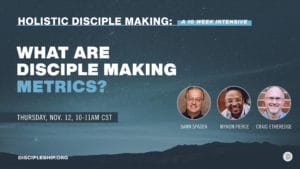Jesus’ third step in making disciples
The third step in Jesus’ disciple-making process was to train new believers to be and build disciples. At this point in Jesus’ ministry, the crowds were swelling to uncontrollable numbers. Mark 3.7-8 says that a “great multitude” followed Jesus from Galilee, Judea, Jerusalem, and even from beyond the borders of Israel, like Tyre and Sidon. People desperate for healing were reaching out just to touch Jesus, and demons were shrieking out of the possessed at Jesus’ command. Jesus knew that it was time to call his leadership team to a new level.
Calling the twelve and starting intentional training
He spent all night praying (Luke 6.12), and in the morning called twelve men to himself, appointing them as apostles. Mark clearly states why Jesus called these men. “He appointed twelve (whom he also named apostles) so that they might be with him and he might send them out to preach….” (Mark 3.14). This was Jesus’ training program. Jesus Boot Camp. From this point forward, Jesus spent four times as much time with these twelve as he did with anyone else. They were clearly his top priority.
The kingdom of God was Jesus’ core curriculum
Throughout the next six to nine months, Jesus poured into his disciples what it meant to be a part of the Kingdom of God. The more I study this period of time in Jesus’ ministry, the more I become convinced that the kingdom of God was Jesus’ main theme. It’s as if teaching on the kingdom (the rule and reign of God on the earth and in heaven) was Jesus’ curriculum for making disciples.
Immediately after choosing his twelve leaders, Jesus sat them down and began to teach them about the Kingdom in what we know as the Sermon on the Mount. Jesus taught about the character of those in the kingdom of heaven (Matthew 5.1-12), the influence of those in the kingdom (Matthew 5.13-16), the morality of those in the kingdom (Matthew 5.17-48), and the spiritual practices of those in the kingdom (Matthew 6.1-24). He taught them about trust in the kingdom, forgiveness in the kingdom, and judgment in the kingdom (Matthew 6.25-7.27).
The kingdom of God was Jesus’ core curriculum
Following the sermon, Jesus demonstrated how a person enters the Kingdom of God. Those who exercise faith and trust in him, no matter their background, find acceptance in the kingdom. Those who reject Jesus, no matter their religious pedigree, fall short of the kingdom.
Jesus marveled at the great faith of a Roman Centurion (Luke 7.1-10) and the humility of a sinful woman (Luke 7.36-50). Jesus also was grieved by the lack of faith of those in the Jewish communities of Chorazin and Bethsaida (Matthew 11.20-30) and the hard-hearted religious leaders who were always looking for a sign (Mark 3.20-30; Matthew 12.38-45). All the while, Jesus taught that those in the kingdom have a new family, the family of God (Luke 8.19-21).
The kingdom of God was Jesus’ core curriculum
During this time, Jesus taught about the kingdom of God using parables. Through stories about soils and seeds (Luke 8.5-18), wheat and tares (Matthew 13.2430), leaven and bread (Matthew 13.33-35), treasures and pearls (Matthew 13.44-46), and fish and mustard seeds (Matthew 13.47-50; Mark 4.30-32) Jesus illustrated what the kingdom of heaven is like.
The kingdom of God was Jesus’ core curriculum
Jesus also demonstrated the power of the kingdom over earthly powers. He demonstrated his power over the natural elements by calming the storm (Luke 8.22-25). He demonstrated his power over demons by healing the demonic from Gerasene (Luke 8.26-39). He demonstrated his power over illness by healing a sick woman (Luke 8.4348) and his power over death by raising a dead daughter (Luke 8.40-43, 49-56).
Equipping his disciples to go and do likewise
Through it all, Jesus was preparing his disciples to do what he was doing. After approximately six to nine months, his disciples were ready to fly solo. He sent them out in pairs into the villages to preach repentance, and he gave them power over evil spirits (Matthew 11.1; Luke 9.6). When they came back, they reported all that had happened (Luke 9.10; Mark 6.30). He was intentionally training these men to reproduce.
The church must intentionally train disciple-makers
For a church to be a disciple-making church, it must intentionally train people to walk with God and reproduce. When a soldier enlists in the Marines, he is immediately indoctrinated into that culture. The Marine Corps cuts the new recruits’ hair, changes their clothes, and redefines their new family. Imagine what would happen if they did all of that and then simply released the new recruits to the front lines without training them to shoot a weapon or survive a firefight. They wouldn’t last long.
Unfortunately, that’s what many churches do with new believers. We celebrate their new faith in Jesus, we accept them into the church, we give them a Bible, and teach them a few worship songs. But we never train them to walk with God on their own. We don’t train them in the practical basics of prayer, Bible study, sharing their faith, forgiveness, love, and perseverance. We don’t train them to rely on Jesus in a storm or to fight doubt and discouragement with truth. Is it any wonder that the attrition rate is so high in the church?
The goal is maturity and multiplication
Jesus intentionally trained his men, and we must do the same. In our church, we have chosen a few tools that we have used over the years to invest in the lives of people who are ready and wanting more. That training could last as long as nine months to a year. But the result is a disciple who is no longer dependent on someone else to feed him; he can feed himself. He is no longer an infant, but instead is a mature adult in the faith. He is mature, strong, tested, steady, and able to train others to be the same.
The Apostle Paul said the purpose of the church is to train believers “until we all attain to the unity of the faith and of the knowledge of the Son of God, to mature manhood to the measure of the stature of the fullness of Christ” (Ephesians 4.13). He told the Colossians that his desire was to “present everyone mature in Christ” (Colossians 1.28). A disciple-making church trains, equips, and grows believers to be self-sustaining, reproducing followers of Christ.
This blog features an excerpt from one of our books, Walk With God.







